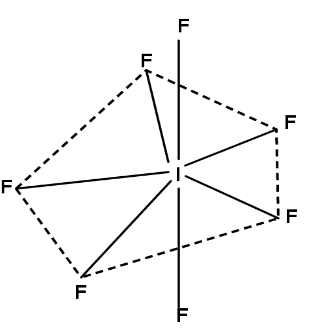
What is the structure of
Answer
409.8k+ views
Hint :Iodine hypo fluoride or iodine (VII) chloride are other names for
Complete Step By Step Answer:
The core atom I(iodine) is connected to 7 fluorine atoms via 7 sigma bonds in
Let’s look how the structure comes:
Iodine(atomic no.=53)
Look at the following image:
In first excited state its electronic configuration changes:
Hence we can see that there are 7 fluorine molecules. One enters
Hence we can make out that the hybridization is
Let's look at the structure:

This is pentagonal bi-pyramidal. Also not every bonding angle is the same. Five electron pairs are on the same plane at a 72-degree angle, while the other two are perpendicular to the plane and make a 90-degree angle with it. Even bond lengths differ. The axial bonds are 186pm long, whereas the equatorial bonds are 179pm long.
Note :
There can be many ionization states of an element. But whenever we draw structures we should only consider the first excited state and calculate the hybridization.
Also The primary distinction between axial and equatorial positions is that axial bonds are vertical, whereas equatorial bonds are horizontal. The phrases axial and equatorial are critical when illustrating the real 3D orientation of chemical bonds.
It is not necessary to mention bond angles and bond lengths while drawing the structure.
Complete Step By Step Answer:
The core atom I(iodine) is connected to 7 fluorine atoms via 7 sigma bonds in
Let’s look how the structure comes:
Iodine(atomic no.=53)
Look at the following image:
In first excited state its electronic configuration changes:
Hence we can see that there are 7 fluorine molecules. One enters
Hence we can make out that the hybridization is
Let's look at the structure:

This is pentagonal bi-pyramidal. Also not every bonding angle is the same. Five electron pairs are on the same plane at a 72-degree angle, while the other two are perpendicular to the plane and make a 90-degree angle with it. Even bond lengths differ. The axial bonds are 186pm long, whereas the equatorial bonds are 179pm long.
Note :
There can be many ionization states of an element. But whenever we draw structures we should only consider the first excited state and calculate the hybridization.
Also The primary distinction between axial and equatorial positions is that axial bonds are vertical, whereas equatorial bonds are horizontal. The phrases axial and equatorial are critical when illustrating the real 3D orientation of chemical bonds.
It is not necessary to mention bond angles and bond lengths while drawing the structure.
Recently Updated Pages
Master Class 11 Economics: Engaging Questions & Answers for Success

Master Class 11 Business Studies: Engaging Questions & Answers for Success

Master Class 11 Accountancy: Engaging Questions & Answers for Success

Master Class 11 English: Engaging Questions & Answers for Success

Master Class 11 Computer Science: Engaging Questions & Answers for Success

Master Class 11 Maths: Engaging Questions & Answers for Success

Trending doubts
What are Quantum numbers Explain the quantum number class 11 chemistry CBSE

Why is steel more elastic than rubber class 11 physics CBSE

Explain why a There is no atmosphere on the moon b class 11 physics CBSE

In northern hemisphere 21st March is called as A Vernal class 11 social science CBSE

Balance the equation KOH + H2SO4 to K2SO4 + H2O class 11 chemistry CBSE

A dimensionless quantity A Never has a unit B Always class 11 physics CBSE




